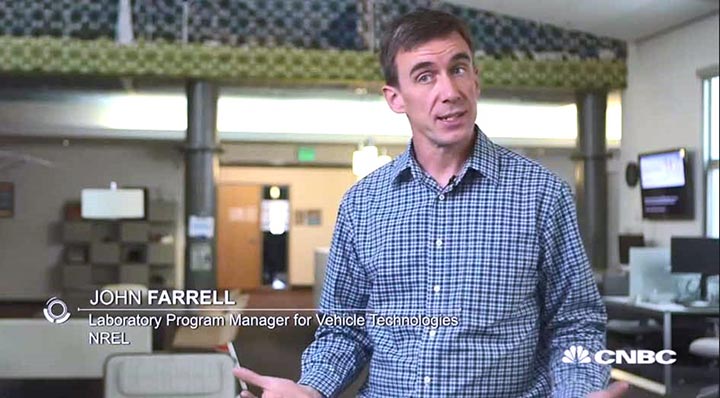International Interest in NREL's Fuels and Engines Research
The European Union's goal is for 10% of all of Europe's transportation fuels to come from renewable sources by 2020. In April, CNBC World's international news program "Sustainable Energy" came to NREL to spotlight how the lab's breakthrough biofuels research is advancing progress toward that ambitious objective.

While electric cars are rapidly gaining market share, the vast majority of vehicle technology and fueling infrastructure is still designed for use with liquid fuels. NREL researchers are working to maximize the efficiency of cars and trucks through the development of high-performance engines and fuels—including biofuels made from plentiful U.S. feedstocks.
The CNBC World feature, which was also picked up by the U.S. edition of CNBC, explains how NREL advancements in fuels, engines, and the synchronization of the two are targeting double-digit improvements in fuel efficiency and dramatic cost savings.
"Biofuels are very important for sustainable transportation," said National Bioenergy Center Director Tom Foust. "Biofuels designed intelligently can provide meaningful efficiency gains and emission benefits in synergy with their hydrocarbon counterparts, for a very sustainable, clean transportation energy future."
In its more than 40 years of research, the National Bioenergy Center at NREL has worked to make biofuels from non-food plant sources (cellulosic biomass) that are high-yield and cost-effective. Toward that end, the lab has demonstrated that cellulosic biofuels can be produced for $2.15/gallon—a competitive price in many fuels markets.
But there is work to be done. As Heterogeneous Catalyst Research and Development Group Manager Jesse Hensley explained, biofuels face a barrier—commonly referred to as the "blend wall"—in the form of the amount of biofuel that can be combined with conventional gasoline.
"The ethanol blend wall represents the amount of ethanol we can blend into gasoline without coming up against regulatory limits," he explained. "In the U.S. it's been sitting at 10% by volume ethanol for some time and is regulated by both the EPA [U.S. Environmental Protection Agency] for emissions purposes—from the tank and out the tail pipe—and is also regulated in the auto industry where they need to be able to design and warrant their engines to run off the fuel that contains ethanol."
Hensley said raising that percentage can be done but that there are technical challenges. "Some fuels will burn well in a car but they're chemically different than what we currently see today. We need to understand more about what their long-term impacts are on engines and emissions."
The Optimization of Fuels and Engines: A Matter of Timing
Enter the Co-Optimization of Fuels & Engines (Co-Optima) Initiative, an NREL-led consortium of nine national laboratories, 13 universities, and numerous industry partners that combine efforts to simultaneously maximize performance and efficiency of fuels and engines.
As Laboratory Program Manager for Vehicle Technologies and Co-Optima Project Leader John Farrell told CNBC World, the fuels currently on the market constrain engine design and limit their efficiency. NREL researchers and their partners in the Co-Optima Initiative are working to break through those constraints by identifying key properties for new fuels and assessing compatibility with vehicle components and infrastructure, pointing to solutions for the entire on-road fleet.
"New engines that are designed to take advantage of new fuel properties have significantly higher fuel economy," said Farrell. "The fuel efficiency could be 35% greater than a 2015 car, for example."
Co-Optima analyses estimate that that level of fuel efficiency improvement could contribute to an annual savings of $20 billion to $30 billion in fuel costs in the light-duty vehicle fleet in the United States. And that possibility has attracted the world's attention.
Last Updated May 28, 2025
